Cancer survival in Kampala, Uganda
- PMID: 15827554
- PMCID: PMC2362045
- DOI: 10.1038/sj.bjc.6602540
Cancer survival in Kampala, Uganda
Abstract
Epidemiological data on the occurrence of cancer in sub-Saharan Africa are sparse, and population-based cancer survival data are even more difficult to obtain due to various logistic difficulties. The population-based Cancer Registry of Kampala, Uganda, has followed up the vital status of all registered cancer patients with one of the 14 most common forms of cancer, who were diagnosed and registered between 1993 and 1997 in the study area. We report 5-year absolute and relative survival estimates of the Ugandan patients and compare them with those of black American patients diagnosed in the same years and included in the SEER Program of the United States. In general, the prognosis of cancer patients in Uganda was very poor. Differences in survival between the two patient populations were particularly dramatic for those cancer types for which early diagnosis and effective treatment is possible. For example, 5-year relative survival was as low as 8.3% for colorectal cancer and 17.7% for cervical cancer in Uganda, compared with 54.2 and 63.9%, respectively, for black American patients. The collection of good-quality follow-up data was possible in the African environment. The very poor prognosis of Ugandan patients is most likely explained by the lack of access to early diagnosis and treatment options in the country. On the policy level, the results underscore the importance of the consistent application of the national cancer control programme guidelines as outlined by the World Health Organization.
Figures
References
-
- Brenner H, Hakulinen T (2003) On crude and age-adjusted relative survival rates. J Clin Epidemiol 56: 1185–1191 - PubMed
-
- Brenner H, Hakulinen T, Gefeller O (2002) Computational realization of period analysis for monitoring cancer patient survival. Epidemiology 13: 611–612 - PubMed
-
- Chokunonga E, Ramanakumar AV, Nyakabau AM, Borok MZ, Chirenje ZM, Sankila R, Parkin DM (2004) Survival of cervix cancer patients in Harare, Zimbabwe, 1995–97. Int J Cancer 109: 274–277 - PubMed
-
- Ederer F, Axtell LM, Cutler SJ (1961) The relative survival rate: a statistical methodology. Natl. Cancer Inst Monogr 6: 101–121 - PubMed
-
- Gondos A, Chokunonga E, Brenner H, Parkin DM, Sankila R, Borok MZ, Chirenje ZM, Nyakabau AM, Bassett MT (2004) Cancer survival in a southern African urban population. Int J Cancer 112: 860–864 - PubMed
Publication types
MeSH terms
LinkOut - more resources
Full Text Sources


